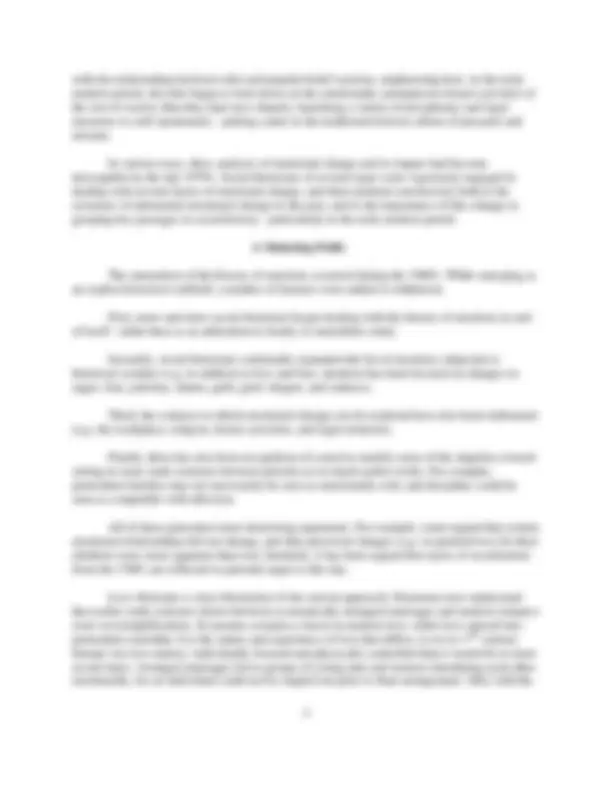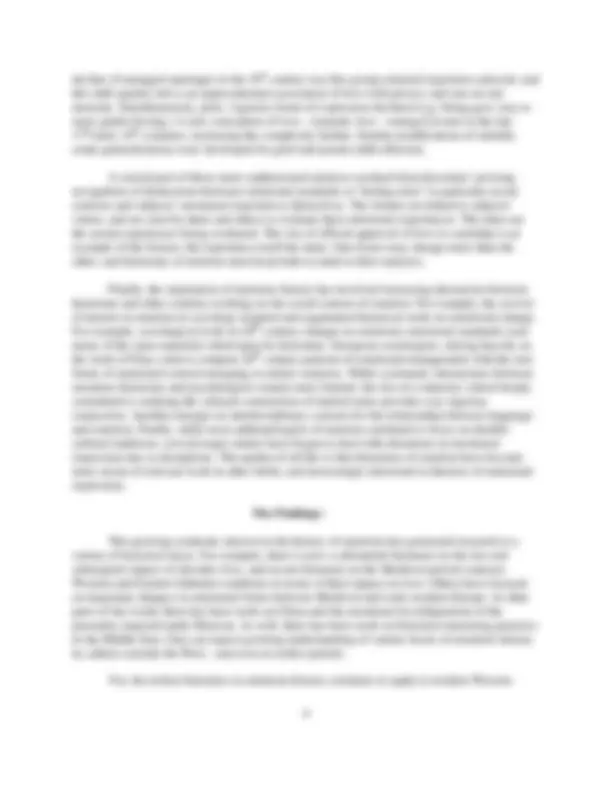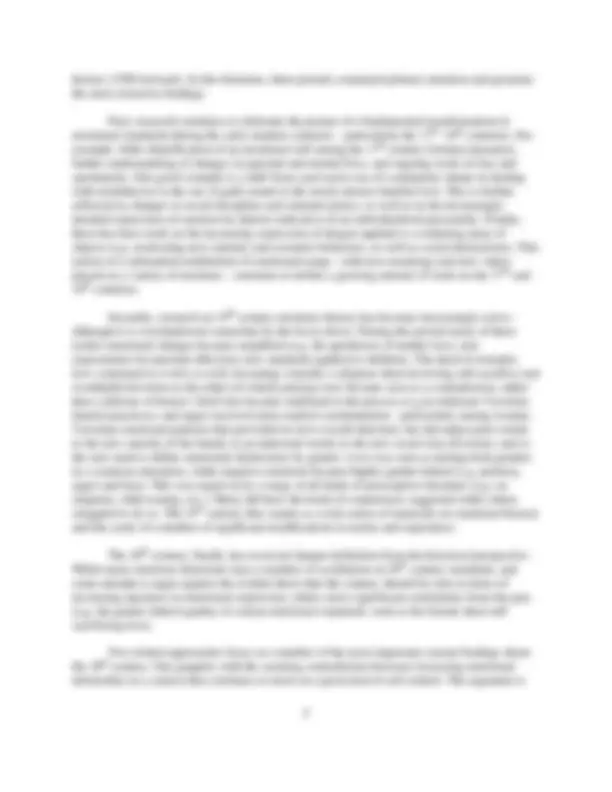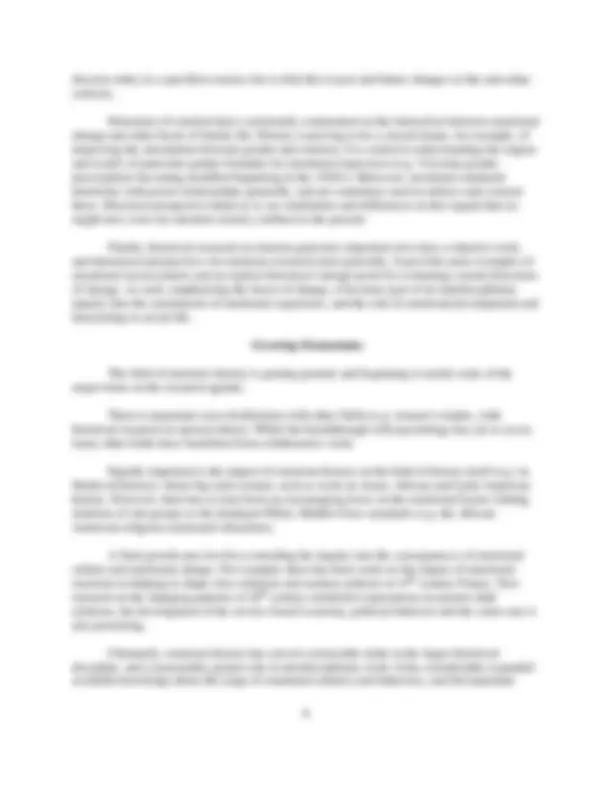







Study with the several resources on Docsity

Earn points by helping other students or get them with a premium plan


Prepare for your exams
Study with the several resources on Docsity

Earn points to download
Earn points by helping other students or get them with a premium plan
Community
Ask the community for help and clear up your study doubts
Discover the best universities in your country according to Docsity users
Free resources
Download our free guides on studying techniques, anxiety management strategies, and thesis advice from Docsity tutors
The expanding field of historical research on emotions, focusing on changes in emotional standards and experiences throughout history. How historians have shifted their focus from objective factors to emotional quality in family relationships, and how emotional change has become an essential topic in social history. It also highlights the growing recognition of emotional distinctions in various social contexts and the importance of interaction between historians and scholars in other fields.
Typology: Study notes
1 / 9

This page cannot be seen from the preview
Don't miss anything!






Sociology 3308: Sociology of Emotions
Prof. J. Scott Kenney
Lectures 4 - 5: The History of Emotions:
Historical work on emotions, though new as a field, is expanding rapidly. Its principal focus is straightforward, dealing with the processes of change in emotional standards and emotional experience, as well as emotional continuities amid changing historical contexts. Historians may also be interested in getting at the characteristic emotional styles of a particular period as a means of comparison or rounding out our understanding. Ultimately, however, the analytical goals center on change in emotions or their environment over time. For, if emotions change over time, then this must be grasped even for an understanding of emotions in the present. It will provide an essential perspective for assessing the results of other social science work on emotions. This involves establishing emotional baselines, so that new trends can be assessed against real, rather than imagined past standards, assessing the causes of change and its results - both personally and in larger institutions as well.
The Development of Emotions History:
The development of emotions history as a subfield can be traced to the work of Norbert Elias (1938). His classic work focused on how new levels of Acivilization@ began to constrain spontaneous emotional expressions, beginning with the Western European aristocracy by the 18th century. This work focused historians= attention on European sociologists dealing with emotion, as well as the more general constructivist theory arguing that emotions should be interpreted in terms of the functions they serve (i.e. as social functions change, emotions will as well). This richly suggestive framework, where cultural context was seen as the intermediary between function and emotion, had only been rarely fleshed out by detailed historical research, and was largely ignored by professional historians.
Yet historians themselves moved into research on emotions hesitantly. While Lucien Febvre almost 70 years ago called for a Ahistorical psychology,@ his appeal was not quickly heeded. A number of cultural historians dealt with past styles and rituals that had strong emotional components (e.g. during the Middle Ages), but explicit focus on emotion was lacking. Most historians continued to emphasize the conscious actions and rational decisions of their subjects. Even the advent of social history in the U.S. - focused as it was on groups of ordinary people - did not break this mold. Indeed, it was focused on rescuing ordinary people from the image of an impulsive mob, so stressed their rationality.
The advent of psychohistory in the 1960's brought attention to the role of emotions in the past, but on a very limited scale. From Erik Erickson (1958) to more recent writers, the emphasis was on biography analyzed through a Freudian framework (e.g. Martin Luther=s tense relationship with his harsh father coloring Lutheranism=s preoccupation with an angry and omnipotent God). This restricted emphasis has not dealt with emotional change, and tended to
enmesh emotional factors in a rigid and unchanging psychodynamic. Moreover, this approach has never won wide acceptance within the historical discipline nor other fields.
Nevertheless, prior to the development of explicit historical work on emotions, these several approaches above pointed to promising lines of inquiry. Thus, it was hardly surprising that as emotions research revived in many disciplines by the late 1970's that historians began to contribute significantly to the agenda.
Yet one final ingredient was needed: the maturation of social history in the 1970's as the leading branch of historical research. By this time, American and European historians focused not only on the activities and value systems of ordinary people, but also on institutions and behaviors in addition to formal politics as the central stuff of the past. New topics meant new materials, promoted the analysis of change, and displaced the mere narration of political and military events.
From social history, then, issues emerged that led a number of historians to consider emotional patterns as central to their task, and this encouraged a confluence of work with other disciplines dealing with the social contexts of emotional life. For example, social historians developed a strong interest in family history, quickly moving from so-called Aobjective@ factors like family organization to the study of the emotional quality of family relationships (e.g. fewer children = more intense emotional bonds). This also helped historians better understand how changes in economics affected age ratios between partners, courtship behaviors, marriage patterns, family size, etc. The social history of emotion was born, above all, from the progressive extension of family history.
By the late 1970's various studies were directly confronting the emotional aspects of family history. European scholars uncovered a pronounced increase in familial affection in the late 17th^ and 18th^ centuries, contrasting with the more restrained emotional tone previously (e.g. attempts in the Plymouth, Mass. Colony to keep families from bickering was accompanied by the encouragement of conjugal love). Similarly, in Europe, child-rearing methods that had previously focused on breaking children=s wills gradually - and unevenly - yielded to greater reliance on affectionate persuasion centred around the mother. Romantic love began to influence courtship and marital expectations. As the family declined as a purely economic unit, it began taking on new emotional functions and to generate new expectations.
While this expansion of family history began to introduce emotional change as an explicit historical topic, another kind of social history was promoting attention to different emotional issues. French historians led the way in historical Amentalities@ research - focusing in on deeply held popular beliefs about self, environment and society, largely as expressed in ritual. For example, they began probing into what ordinary people really meant by their religious observances, uncovering how a variety of magical ingredients still held sway. Emotional beliefs increasingly became central to such analyses (e.g. perpetual uncertainty in many areas leading to the high levels of fear exhibited by Medieval French peasants, and expressed in a variety of their religious and magical practices that served to Amanage@ this). Mentalities researchers also dealt
decline of arranged marriages in the 18th^ century was this group-oriented experience pierced, and this shift quickly led to an unprecedented association of love with privacy and one-on-one intensity. Simultaneously, prior, vigorous forms of expression declined (e.g. biting gave way to more gentle kissing.) A new conception of love - romantic love - emerged in turn in the late 17 th/early 18th^ centuries, increasing the complexity further. Similar modifications of initially crude generalizations were developed for grief and parent-child affection.
A crucial part of these more sophisticated analyses resulted from historians= growing recognition of distinctions between emotional standards or Afeeling rules@ in particular social contexts and subjects= emotional experiences themselves. The former are linked to subjects= values, and are used by them and others to evaluate their emotional experiences. The latter are the actual experiences being evaluated. The rise of official approval of love in courtship is an example of the former; the experience itself the latter. One factor may change more than the other, and historians of emotion must keep both in mind in their analyses.
Finally, the maturation of emotions history has involved increasing interaction between historians and other scholars working on the social context of emotion. For example, the revival of interest in emotion in sociology inspired and augmented historical work on emotional change. For example, sociological work on 20th^ century changes in emotions/ emotional standards used many of the same materials relied upon by historians. European sociologists, relying heavily on the work of Elias, tried to compare 20th^ century patterns of emotional management with the new forms of emotional control emerging in earlier centuries. While systematic interactions between emotions historians and psychologists remain more limited, the rise of a minority school deeply committed to studying the cultural construction of mental states provides one vigorous connection. Another emerges in interdisciplinary concern for the relationship between language and emotion. Finally, while most anthropologists of emotion continued to focus on durable cultural traditions, several major studies have begun to deal with alterations in emotional expression due to disruptions. The upshot of all this is that historians of emotion have become more aware of relevant work in other fields, and increasingly interested in theories of emotional expression.
The Findings:
This growing academic interest in the history of emotions has generated research in a variety of historical areas. For example, there is now a substantial literature on the rise and subsequent impact of chivalric love, and recent literature on the Medieval period contrasts Western and Eastern Orthodox traditions in terms of their impact on love. Others have focused on important changes in emotional forms between Medieval and early modern Europe. In other parts of the world, there has been work on China and the emotional reconfiguration of the peasantry required under Maoism. As well, there has been work on historical mourning practices in the Middle East. One can expect growing understanding of various facets of emotions history in cultures outside the West - and even in earlier periods.
Yet, the richest literature on emotions history continues to apply to modern Western
history (1500 forward). In this literature, three periods command primary attention and generate the most extensive findings.
First, research continues to elaborate the picture of a fundamental transformation in emotional standards during the early modern centuries - particularly the 17th^ -18th^ centuries. For example, fuller identification of an emotional self among the 17th^ century German peasantry, further understanding of changes in parental and marital love, and ongoing work on fear and spontaneity. One good example is a shift from a pervasive use of community shame in dealing with misbehavior to the use of guilt rooted in the newly intense familial love. This is further reflected in changes in social discipline and criminal justice, as well as in the increasingly detailed expression of emotion by diarists indicative of an individualized personality. Finally, there has been work on the increasing expression of disgust applied to a widening array of objects (e.g. motivating new sanitary and cosmetic behaviors, as well as social distinctions). This notion of a substantial redefinition of emotional range - with new meanings and new values placed on a variety of emotions - continues to define a growing amount of work on the 17th^ and 18 th^ centuries.
Secondly, research on 19th^ century emotions history has become increasingly active - although it is overshadowed somewhat by the focus above. During this period many of these earlier emotional changes became amplified (e.g. the apotheosis of mother love; new expectations for parental affection; new standards applied to children). The ideal of romantic love continued to evolve as well, becoming virtually a religious ideal involving self-sacrifice and worshipful devotion to the other (of which jealousy now became seen as a contradiction, rather than a defense of honor). Grief also became redefined in the process (e.g in elaborate Victorian funeral practices), and anger received more explicit condemnation - particularly among women. Victorian emotional patterns thus provided no new overall direction, but did adjust prior trends to the new sanctity of the family in an industrial world; to the new social class divisions; and to the new need to define emotional distinctions by gender. Love was seen as uniting both genders in a common enterprise, while negative emotions became highly gender-linked (e.g. jealousy, anger and fear). This was urged on by a surge of all kinds of prescriptive literature (e.g. on etiquette, child rearing, etc.). Many did have the kinds of experiences suggested while others struggled to do so. The 19th^ century thus stands as a rich source of materials on emotional history and the scene of a number of significant modifications in norms and experience.
The 20th^ century, finally, has received sharper definition from the historical perspective. While many emotions historians trace a number of oscillations in 20th^ century standards, and some attempt to argue against the evident thesis that the century should be seen in terms of increasing openness in emotional expression, others stress significant continuities from the past (e.g. the gender-linked quality of certain emotional standards, such as the female ideal self- sacrificing love).
Two related approaches focus on a number of the most important current findings about the 20th^ century. One grapples with the seeming contradiction between increasing emotional informality in a context that continues to insist on a great deal of self-control. The argument is
Grasping the emotional dynamics of a past culture also raises the question whether the task of historians is merely to record the emotional language of a past age, or whether they can legitimately interpret past emotions in light of current categories. Some have vigorously argued against this, while others argue that we do this in any event - and couldn=t understand it otherwise.
Emotions history also generates some theoretical issues on its own. These are focused on tracing change. Problems of timing are one example: when emotional standards begin to change in a society, how long does it take for key groups to significantly internalize these? Are there generalizable factors which speed or inhibit such responses? (E.g. the urging against using fear to motivate child obedience began in the early 1800's, but people were still being exhorted to do this a century and more later - suggesting holdouts until at least the 1950's). The issue, then, is what factors slow down or speed up the timing of such changes. Similar questions emerge surrounding the lag between middle-class acceptance of new standards and their translation into new laws (e.g. divorce), or the variations in the timing of such changes among different classes and subcultures.
A second set of theoretical issues involves the relationship between recreations and emotions. Cultural expressions in theatre, music, ritual and sport, for example, sometimes serve to train individuals in dominant emotional norms. Other times, they serve as outlets for emotions that are frowned upon in daily life (e.g. spectator sports serve as an outlet for aggression). Such work needs further theoretical integration with emotions history.
The Strengths of the Historical Approach:
In the end, the strength of the historical approach to emotions is in its generation of important findings about changes in standards and their relationship to aspects of emotional experience (e.g. the direction of changes in 3 major periods in modern Western history). These add evidence and issues to a number of basic discussions in emotions research and generate additional theoretical problems associated with the phenomenon of change.
History also permits deeper exploration of the causation operating in the social context of emotions (suggested by constructivist theory but not systematically probed). It deals with the factors inducing new emotional formulations, permitting a kind of causal analysis that is more extensive than that possible in cross-cultural variations. For example, so far historians have noted how shifts in larger beliefs have induced new emotional standards (e.g. the Reformation encouraged reevaluation of emotions in the family). A second form of causal analysis focuses initially on changes in economic and organizational systems as reflected in emotions (e.g. the separation of home and work prompting emotional reevaluations; the rise of the service economy reflected in emotional materialism). While definitive statements of causation remain elusive, the analytical task has been engaged - and is relevant to other social research on emotion as well.
Historical research also encourages renewed attention to the impact of emotion and emotional standards on change. Historians do not simply attempt to understand emotion as a
discrete entity in a specified context, but to link this to past and future changes in this and other contexts.
Historians of emotion have consistently commented on the interaction between emotional change and other facets of family life. History is proving to be a crucial means, for example, of improving the articulation between gender and emotion. It is central to understanding the origins and results of particular gender formulas for emotional expression (e.g. Victorian gender prescriptions becoming modified beginning in the 1920's). Moreover, emotional standards intertwine with power relationships generally, and are sometimes used to enforce and conceal these. Historical perspective helps us to see similarities and differences in this regard that we might miss were our attention merely confined to the present.
Finally, historical research on emotion generates important new data, evaluative tools, and theoretical perspectives for emotions research more generally. It provides prior examples of emotional reassessments and an explicit historical vantage point for evaluating current directions of change. As such, emphasizing the factor of change, it becomes part of an interdisciplinary inquiry into the constituents of emotional experience, and the role of emotional development and functioning in social life.
Growing Momentum:
The field of emotions history is gaining ground, and beginning to tackle some of the major items on the research agenda.
There is important cross-fertilization with other fields (e.g. women=s studies, with historical research on spousal abuse). While the breakthrough with psychology has yet to occur, many other fields have benefitted from collaborative work.
Equally important is the impact of emotions history on the field of history itself (e.g. on Medieval history). Some big tasks remain, such as work on Asian, African and Latin-American history. However, there has at least been an encouraging focus on the emotional factors linking relations of sub-groups to the dominant White, Middle-Class standards (e.g. the African- American religious emotional subculture).
A final growth area involves extending the inquiry into the consequences of emotional culture and emotional change. For example, there has been work on the impact of emotional reactions in helping to shape class relations and sanitary policies in 19th^ century France. New research on the changing patterns of 20th^ century emotional expectations on parent-child relations, the development of the service-based economy, political behavior and the crime rate is also promising.
Ultimately, emotions history has carved a noticeable niche in the larger historical discipline, and a measurably greater role in interdisciplinary work. It has considerably expanded available knowledge about the range of emotional cultures and behaviors, and fed important